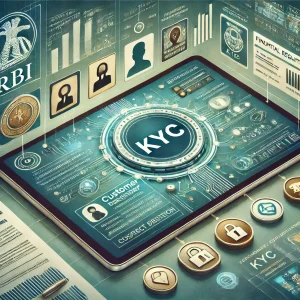Recently the threat of financial crimes has reached unprecedented levels of sophistication, posing significant challenges to financial institutions worldwide. From money laundering to terrorist financing, these illicit activities not only undermine the integrity of financial systems but also have far-reaching consequences on global security and economic stability. As a result, regulatory bodies have intensified their efforts to enforce robust compliance frameworks that can effectively combat these threats.
At the heart of these frameworks lie Anti-Money Laundering (AML) and Know Your Customer (KYC) regulations, which are designed to help financial institutions identify, monitor, and mitigate the risks associated with illicit financial activities. These regulations are not just legal obligations but essential tools for maintaining the trust and stability of financial systems.

Get all AML updates in your pocket! Follow us on LinkedIn Now!
Download our Report on Emerging AML & KYC Challenges For Fintechs In India
Traditionally, AML and KYC processes have been treated as distinct functions within financial institutions, each with its own set of procedures, technologies, and compliance requirements.
- KYC focuses on verifying the identity of customers and assessing their risk profiles during the onboarding process.
- AML involves the ongoing monitoring of transactions to detect and report suspicious activities.
However, this approach often leads to inefficiencies, redundancies, and gaps in compliance, making it difficult for institutions to maintain a comprehensive and cohesive risk management strategy. Recognizing these challenges, a growing number of financial institutions are now moving towards the integration of AML and KYC processes. This integrated approach not only streamlines compliance efforts but also enhances the institution’s ability to develop a holistic view of customer activities, thereby improving overall risk management and regulatory adherence.
The Current Landscape: AML And KYC
Historically, AML and KYC processes have been implemented as distinct functions within financial institutions. KYC procedures involve verifying the identity of clients, assessing their financial activities, and understanding their risk profile. This process is typically conducted at the onboarding stage and periodically updated. AML, on the other hand, focuses on monitoring transactions to detect suspicious activities that could indicate money laundering or terrorist financing. The separation of these functions can lead to several challenges like:
- Redundant Processes: Repeated customer information collection across different departments can lead to inefficiencies and increased operational costs.
- Data Silos: Information gathered during KYC processes might not be effectively utilized in AML monitoring, leading to incomplete risk assessments.
- Inconsistent Risk Profiling: Without a unified approach, the risk profile developed during the KYC process may not align with the transaction monitoring efforts of AML teams, resulting in potential blind spots.
The Case For Integration: Benefits And Strategic Advantages
Integrating AML with KYC processes can address the inefficiencies and gaps that arise from their siloed implementation. Read below to know the benefits of integration.
Enhanced Customer Risk Profiling
By combining KYC data with ongoing AML transaction monitoring, institutions can develop a more comprehensive and dynamic risk profile of their customers. This allows for more accurate detection of suspicious activities and the identification of high-risk customers.
Operational Efficiency
Integration reduces redundancy in data collection and processing, leading to significant cost savings. It also streamlines compliance workflows, enabling institutions to respond more swiftly to regulatory requirements and audits.
Improved Data Utilization
A unified approach ensures that the data collected during KYC is continuously utilized and updated during AML monitoring. This enhances the overall quality of data, leading to more effective risk management.
Regulatory Compliance
As regulatory bodies increasingly emphasize the importance of holistic risk management; the integration of AML and KYC processes aligns with global regulatory expectations. This can help institutions avoid fines and penalties while demonstrating a proactive approach to compliance.
Customer Experience
Streamlining compliance processes can also enhance the customer experience by reducing the burden of repetitive information requests and delays in transaction processing.
Try our AML Screening Tool to get your compliance on track!
What Are The Challenges And Considerations In AML/KYC Integration?
Top 5 Best Practices For Successful AML/KYC Integration
1. Leverage Technology
Advanced technologies such as artificial intelligence (AI) and machine learning (ML) can play a pivotal role in integrating AML and KYC processes. These technologies can automate data collection, enhance data analysis, and improve the accuracy of risk assessments.
2. Centralized Data Management
Establishing a centralized data repository that consolidates customer information from both AML and KYC processes is crucial. This allows for real-time data sharing and ensures that all relevant information is accessible to both compliance and risk management teams.
3. Cross-Functional Collaboration
Fostering collaboration between AML and KYC teams is essential for successful integration. This can be achieved through joint training programs, regular communication, and the establishment of cross-functional teams.
4. Regulatory Alignment
Institutions must ensure that their integrated AML-KYC processes are aligned with the latest regulatory requirements. This involves staying up to date with regulatory changes and engaging with regulators to understand their expectations.
5. Continuous Monitoring And Improvement
The integration of AML and KYC processes should not be viewed as a one-time project but as an ongoing initiative. Institutions should continuously monitor the effectiveness of their integrated approach and make improvements as needed.
Streamlining Compliance With ZIGRAM's Integrated AML And KYC Solutions
The integration of AML and KYC processes represents a significant opportunity for financial institutions to enhance their compliance frameworks, improve risk management, and achieve operational efficiencies. While the journey to integration may be challenging, the strategic advantages it offers make it a worthwhile investment. By leveraging technology, fostering cross-functional collaboration, and staying aligned with regulatory requirements, institutions can successfully integrate AML and KYC processes, ensuring a more robust and effective approach to combating financial crime.
ZIGRAM’s comprehensive Anti-Money Laundering (AML) system offers a full AML flow that encapsulates the entire compliance journey, streamlining the integration of key components. The system begins by processing input data sources, such as customer KYC data—collected during the onboarding phase—and transaction data, which includes payments and even crypto transactions. This data forms the foundation for robust customer risk rating and categorization, where customers are classified into high, medium, or low risk. ZIGRAM’s Entity Hero platform plays a key role here by continuously managing entity data and ensuring proper risk categorization.
Beyond categorization, ZIGRAM’s tools such as PreScreening.io facilitate name screening and updates against watchlists and sanctions, providing an ongoing layer of scrutiny to ensure compliance with global regulatory standards. Simultaneously, transaction data is continuously monitored through Transact Comply, which applies specific scenarios and thresholds to flag any suspicious activity in real time. Both name screening and transaction monitoring undergo regular updates, ensuring that risk management remains dynamic and responsive to new information.
In essence, ZIGRAM’s AML solution illustrates how customer and transaction data flow seamlessly through a unified system, powered by tools like PreScreening.io for screening, Transact Comply for monitoring, and Entity Hero for risk rating. This comprehensive approach not only ensures compliance but also enables financial institutions to stay ahead in the fight against financial crime with real-time data and ongoing updates.
ZIGRAM is the one-stop solution for all your compliance needs. Try our FREE DEMO to experience what you’re missing in your AML and KYC processes!
- #aml
- #kyc
- #Compliance
- #integration
- #RegTech






